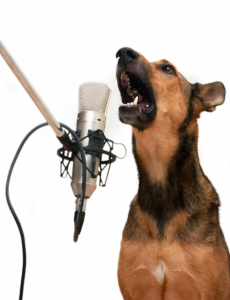 Barking is loud, obnoxious, irritating and is very hard to tolerate. It’s meant to be! When a baby cries, we feel an insurmountable urge to do something about it. In the same way, when our dog barks, we’re compelled to act upon it and make it stop. Barking is a signal to others of an urgent need, and like crying, barking is intentionally so unpleasant that it simply cannot be ignored. Our link to man’s best friend also allows us to recognize the different emotions dogs express with barking (Pongrácz & al., 2005), which means that we can identify when they’re afraid, playful, aggressive, etc. Barking is part of our dog’s normal repertoire, yet barking can be problematic in our modern lifestyles. It only takes a look at the many devices on the market designed to stop barking to see how much effort and money we’re willing to put into stopping the troublesome display. But what can we do about it? What options do we have to stop Fido from interrupting our peace or waking up the neighbors? We’ll try to understand the reasons why our dogs bark so we can address the behavior accordingly. As always, the underlying emotion and motivation behind the behavior is going to determine how we approach the problem for long-term solutions.
Barking is loud, obnoxious, irritating and is very hard to tolerate. It’s meant to be! When a baby cries, we feel an insurmountable urge to do something about it. In the same way, when our dog barks, we’re compelled to act upon it and make it stop. Barking is a signal to others of an urgent need, and like crying, barking is intentionally so unpleasant that it simply cannot be ignored. Our link to man’s best friend also allows us to recognize the different emotions dogs express with barking (Pongrácz & al., 2005), which means that we can identify when they’re afraid, playful, aggressive, etc. Barking is part of our dog’s normal repertoire, yet barking can be problematic in our modern lifestyles. It only takes a look at the many devices on the market designed to stop barking to see how much effort and money we’re willing to put into stopping the troublesome display. But what can we do about it? What options do we have to stop Fido from interrupting our peace or waking up the neighbors? We’ll try to understand the reasons why our dogs bark so we can address the behavior accordingly. As always, the underlying emotion and motivation behind the behavior is going to determine how we approach the problem for long-term solutions.
Since our dog’s behavior is greatly influenced by how we respond to it, let’s first take a look at what do we tend to do when our dog barks? Any loud and repetitive sound is very stressful and will immediately draw our attention. That’s why sirens and alarms are purposely designed this way. Just like when we hear an alarm, when our dog barks, our adrenaline naturally goes up. We get concerned about the neighbors, about the other people we’re passing by and we get irritated. We’re likely to yell, get angry and sometimes even want to hit the dog. The barking has to stop now! Such emotional expressions might work and we may have a chance to interrupt the barking. But long term, any of these reactions is likely to make matters worse. Our display of emotions will only add fuel to the fire. For the dog, it’s like barking along side of him. And when the barking is triggered by anxiety or fear, punishing the dog will only confirm that things are bad. So rule of thumb: no matter the reason for the barking, staying calm is key to making any real difference.
Identifying the types of barking will help us define effective strategies to treat the problem. We can divide the main reasons why dogs bark into four main categories according to their underlying emotions and motivation.
Attention barking
 We’re on the phone, working on our computer or watching TV when, out of the blue, Rufus starts barking at us. He needs something. If he hasn’t been let out for a while or if it’s past his meal-time he might be attempting to get those needs met. This might be a behavior that we would like to encourage as it may prevent potential accidents down the road or keep us from forgetting to feed the dog! Responding to the barking, by attending to the dog’s needs, will reinforce the behavior and the dog will likely do it again. If however we want to discourage the barking, we need to completely ignore the dog until he’s silent for 15-30 seconds, then get up and give him what he needs.
We’re on the phone, working on our computer or watching TV when, out of the blue, Rufus starts barking at us. He needs something. If he hasn’t been let out for a while or if it’s past his meal-time he might be attempting to get those needs met. This might be a behavior that we would like to encourage as it may prevent potential accidents down the road or keep us from forgetting to feed the dog! Responding to the barking, by attending to the dog’s needs, will reinforce the behavior and the dog will likely do it again. If however we want to discourage the barking, we need to completely ignore the dog until he’s silent for 15-30 seconds, then get up and give him what he needs.
If all other needs are met and we can’t think of a reason for the barking, Rufus wants attention. He’s bored and needs something to do. Any attention, as little as can be is better for him than what he currently has: nothing. So talking to him, saying ‘quiet’ or even yelling at him, will get him something. The irony is that when we say ‘quiet’ and the dog stops, we then get rewarded ourselves and fall under the illusion that it worked. But as we take a look at the larger picture, the dog will still bark again and again anytime he needs some attention. So we may have stopped the dog in the moment, but we have also taught the dog how to get us to pay attention to him, even for a few seconds. So how do we stop it?
- Completely ignore the dog while barking. Don’t look at him or talk to him.
- If the barking increases: without a word or a look in his direction, walk away. When a behavior doesn’t work anymore, the dog will increase what used to be successful. Instead of a bark, pause, bark, pause, etc. you may get a bark, bark, BARK, BARK, jump, bark, jump …. Just be prepared and expect it. It’s actually a good sign and a normal part of the process. It’s an extinction burst. But no dog can bark or jump forever, so when Rufus finally calms down, after a few seconds of silence, that’s when you give him some attention. If needed, you can also leave the room completely, closing the door behind you, leaving Rufus all by himself. Come back after a few seconds of calm behavior and repeat anytime the dog starts again. What you’re teaching your dog is that barking at you makes your disappear. It’s the opposite of what he’s looking for, so with repetition, this will stop the attention barking.
- Address the need. Rufus is still bored so it’s important to take his need for exercise or mental stimulation into consideration. Once the dog is no longer barking, look for ways to entertain the dog. A walk in the park, a new toy, a treat dispenser, a training session, are all different ways to keep Rufus happy. For more tips and ideas, you can refer to the blog ‘Enrichment – 8 easy ways to increase your dog’s quality of life’.
Separation anxiety
A dog barking when left alone in the house or in the other room is a dog needing help with coping with separation from his/her owners. We love dogs because of they love being with us so much. This however comes with a price to pay. Being left behind is not easy on the dog and he/she’ll need to learn that it’s OK. Punishment of any kind (like a bark collar) may cease the vocalization but would have terrible effects on the dog’s emotional state. Separation anxiety needs to be addressed through a systematic and gradual process where the dog is left alone for very short periods of time at first. With the help of stuffed toys, remote treating dispensers like the Pet Tutor® or puzzles given to the dog when left alone are key. In many cases it’s worth getting the help of a professional trainer or behaviorist. For more on this subject, you can refer to the blog: ‘Separation anxiety in dogs – a consultant’s high tech toolkit’. I also recommend a great book from Malena DeMartini-Price on the subject: ‘Treating Separation Anxiety in Dogs‘.
Fear, territoriality, protection
 The doorbell rings, Ginger dashes to the door with rapid fire barking. You’re walking in the neighborhood and at the sight of another dog Goldie immediately lunges and barks frenetically. Anytime someone walks by your property, Kermit charges to the fence, barking off the trespasser. Even though the dog may show differences in body language when very afraid or when protective, this type of barking still fits in the same category. A lunging barking dog or a dog barking at a distance with its tail tucked under is a dog that perceives the other person or dog as a threat. Their level of fear may differ as is their fight or flight response, but the underlying emotional state should be treated in the same way. We can call it under-confidence, anxiety or fear, in any case, the dog’s barking is meant to alert of the threat and intimidate the trespasser. As the person or dog walks away the behavior is rewarded. With repetitions, it will only get stronger and stronger. Here again, an electric shock, a squirt of water, shouting or any other form of punishment may temporarily stop the barking, but will only increase the underlying emotion. Sadly, I still today hear from clients that these methods are recommended to them, even by reward based trainers. For best results you need to:
The doorbell rings, Ginger dashes to the door with rapid fire barking. You’re walking in the neighborhood and at the sight of another dog Goldie immediately lunges and barks frenetically. Anytime someone walks by your property, Kermit charges to the fence, barking off the trespasser. Even though the dog may show differences in body language when very afraid or when protective, this type of barking still fits in the same category. A lunging barking dog or a dog barking at a distance with its tail tucked under is a dog that perceives the other person or dog as a threat. Their level of fear may differ as is their fight or flight response, but the underlying emotional state should be treated in the same way. We can call it under-confidence, anxiety or fear, in any case, the dog’s barking is meant to alert of the threat and intimidate the trespasser. As the person or dog walks away the behavior is rewarded. With repetitions, it will only get stronger and stronger. Here again, an electric shock, a squirt of water, shouting or any other form of punishment may temporarily stop the barking, but will only increase the underlying emotion. Sadly, I still today hear from clients that these methods are recommended to them, even by reward based trainers. For best results you need to:
- Stay calm. Don’t make it a big deal yourself. Keeping a light and easy going attitude will help your dog calm down.
- Prevent the behavior from being repeated over and over again. Remove the dog’s accidental exposure to the stimuli.
- Help your dog learn that what is perceived as scary is OK. While at a distance where the dog can still be relatively calm while seeing the trigger, give him/her treats. The goal is to allow for new connections to form in the dog’s mind and replace the existing ones. For more information on this technique, see the blog ‘Reactivity and aggression in dogs – managing and treating’.
- Teach alternative behaviors, like lying on a mat when visitors arrive. You’ll first need to desensitize the dog to the trigger. If it’s a doorbell, ringing the doorbell in the absence of visitors while giving the dog a treat every-time will help the dog establish new reactions to that sound. There are high tech products today that can really help with this step. The Pet Tutor® for instance can automatically dispense treats anytime the doorbell goes off. Better yet, it allows for automatic and gradual desensitization of any sound by playing the recording of the sound at increasing levels (with the IPhone app) while treating the dog.
Excitement
Dogs can bark out of excitement when you get the leash out of the closet, when you come home, when they see another dog, etc. Stopping this type of barking is quite easy. Do not let the dog get what he/she wants while barking. Just wait with the leash in hand, or put it back in the closet, until the dog calms down, then take it out again. Anytime the dog barks, the leash goes away, when he/she calms down, the preparation for the walk starts again. When coming home, ignore the dog as long as he/she is barking and wait for a moment of calm to acknowledge him/her. Allow the dog to approach the other dog only once calmed down, etc. In other words, make sure the dog isn’t rewarded for inappropriate behavior and calmly and patiently wait for the dog to settle down.
There is much more to say about barking, but what’s important to understand is that barking is the expression of an underlying emotional state. Any treatment of the symptom only, the vocalization, is likely to backfire. On the other hand, focusing on helping the dog gain confidence and/or get his/her needs met will automatically solve the barking problem.
Jennifer Cattet Ph.D.


I would like to download this video to show to my behavior clients. Is it available on youtube? I have “Easy Youtube downloader”.
If you click on the Youtube logo at the bottom right of the video, it will take you to Youtube page and you should be able to download it from there.
Yes it’s on YouTube. Just click in the corner of the video to see the link and view it on Youtube
You mention an iPhone app for help in desensitizing a dog to the sound of a doorbell. Please, please, please tell me the name of this app. And does it include other sounds?
Thanks for asking about the iPhone App! This is in the final test stage and should be available soon. Sign for our newsletter(see right hand side of the blog) or visit our Facebook page Smart Animal Training Systems for updates on that and other products. Thanks! Wes
wonderful Article! You have descried things so good. It is very important for a pet owner to understand their pets mood.
The way with which you described the whole blog post is really good.I was really astonished to hear about these types of treatments.